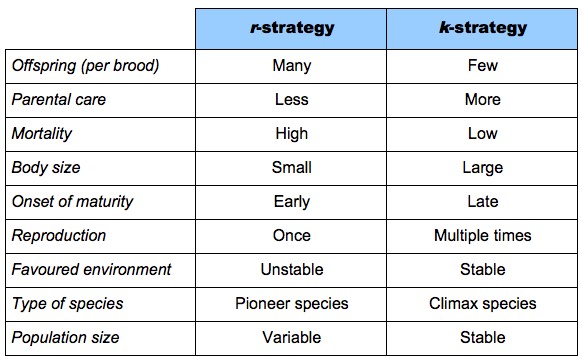G.5.1 Distinguish between r-strategies and k-strategies

G.5.2 Discuss the environmental conditions that favour either r-strategies or k-strategies
r-strategies
- Occur in unstable environments where there are ecological disruptions and resources are used for maximising reproduction (once)
- An environment which would favour r-strategists would be coastal rock pools and an example of an r-strategist is a pathogen or other pest species
k-strategies
- Predominates in stable or predictable environments where resources are invested in maximising long-term survival
- An environment which would favour k-strategists would be a rainforest an examples of k-strategists include humans, elephants and whales
It can be difficult to determine if a species is following an r-strategy or a k-strategy as they represent two extremes of a spectrum
- In actuality, most organisms demonstrate an intermediate strategy and some species may even change strategies depending on the environment
G.5.3 Describe one technique used to estimate the population size of an animal species based on a capture-mark-release-recapture method
The capture-mark-release-recapture method is a means of estimating the population size of a given species in a given environment

Method:
- An area is defined and marked off
- Within this area, a selection of individuals are captured, counted, marked and released (n1)
- Markings may include a spot of paint or an ear tag
- Sufficient time is then allowed to pass to enable released individuals to mix with the population
- A second capture is then made from the same area (n2), with both unmarked and marked (n3) individuals counted
- The Lincoln index is applied to estimate population size: (n1 × n2) ÷ n3
- The Lincoln index assumes that all individuals have an equal chance of selection, marked individuals will be randomly distributed after release and marking will not affect mortality or natality
G.5.4 Describe the methods used to estimate the size of commercial fish stock
Scientists can estimate the size of commercial fish stocks by a number of methods:
- Gathering information from fishermen to determine abundance from quantities caught
- Studying catches to identify fish ages (too few young indicates lack of spawning, while too few old suggests overfishing)
- Using echo sounders to monitor fish populations for density and locations
- Using research vessels and coded wire tag detectors to mark and release fish
G.5.5 Outline the concept of maximum sustainable yield in the conservation of fish stocks
- The maximum sustainable yield (MSY) is the highest proportion of fish that can be removed from the total population without jeopardising this maximum yield in the future
- The MSY will reflect the optimum balance between the reproductive and growth rate of the stock versus the rate of death due to harvesting and natural mortality
- The MSY should be half the carrying capacity of the species, as this is the stage at which population growth will be highest
- Calculating the MSY requires the collection of data over many years (~20 years) – harvesting above the MSY will soon reduce the size future yields
G.5.6 Discuss international measures that would promote the conservation of fish
Large areas of the ocean are not under any specific government's control and thus require international cooperation and legislation
Fish stocks are a renewable resource if managed carefully – international measures that promote the conservation of fish include:
- Limiting total allowable catch size
- Regulating allowable gear (e.g. mesh sizes, banning drift nets, etc.)
- Limiting number of allowable fishing days for fishermen
- Registering and regulating the number of fishing vessels allowed to operate
- Close fishing during fish breeding seasons
- Cordon off certain waters for biological conservation
- Encourage the use of fish farms